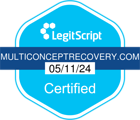Declared a public health emergency in 2017 by the Department of Health and Human Services, opioids have washed over the country like a tidal wave, leaving death, despair and devastation in their wake.
Largely due to reassurances from the pharmaceutical industry that this class of drugs didn’t pose a big risk for addiction, doctors began prescribing them at ever-increasing rates.
This and other contributing factors led to some harrowing statistics:
- In 2018, 128 people in the US were dying per day from opioid overdoses – totaling 47,000 deaths
- 2 out of 3 overdose deaths, also in 2018, involved an opioid
- Between 1999 and 2018, nearly 450,000 died from an overdose involving an opioid
- 2.1 million Americans had opioid use disorder (OUD) in 2016
Despite prescriptions leveling off and beginning to decline in 2012, according to the CDC, “the amount of opioids in morphine milligram equivalents (MME) prescribed per person is still around three times higher than it was in 1999”. Although the number of deaths from overdose has decreased slightly over the past few years, that number was still 4 times higher in 2018 than in 1999.
Given the magnitude of this ongoing crisis, it’s important to understand the warning signs of opioid addiction so you or a loved one doesn’t succumb to addiction as well.
What Are Opioids?
Some background on what exactly they are first though.
Opioids are generally used to relieve moderate to severe pain. Despite the distressing stats above, they are remarkably effective in accomplishing what they’re meant for. They bind to opioid receptors in the brain, spinal cord and other organs and block pain signals. In doing so they release significant amounts of dopamine, which serves to reinforce the taking of the drug.
The National Institute on Drug Abuse adds more color about their dangers, “Opioid pain relievers are generally safe when taken for a short time and as prescribed by a doctor, but because they produce euphoria in addition to pain relief, they can be misused (taken in a different way or in a larger quantity than prescribed, or taken without a doctor’s prescription). Regular use—even as prescribed by a doctor—can lead to dependence and, when misused, opioid pain relievers can lead to addiction, overdose incidents, and deaths”
Commonly Abused Opioids
Opioids come in both legal, prescription form and an illegal variety. The most commonly abused prescription opioids are:
- Hydrocodone (Vicodin)
- Oxycodone (OxyContin)
- Codeine
- Morphine
- Fentanyl
A note on fentanyl, it’s a synthetic opioid that’s similar to morphine but 50 to 100 more potent. It’s meant for the most severe pain.
The most commonly abused illegal opioid is heroin, which is something people sometimes switch to from prescription opioids.
Warning Signs of an Opioid Addiction
Being aware of the warning signs and catching them early can make a huge difference in helping a loved one or yourself before it’s too late. Common signs of addiction to opioids are:
- An inability to control usage, taking more than prescribed or taking opioids for the euphoria rather than what they’re prescribed for
- Taking them when not in pain, “just in case”
- Pulling back from activities, events, etc. as well as friends and family in order to use
- Problems fulfilling obligations at work, school and/or home
- Going to multiple doctors to get prescriptions filled
- Using other people’s opioids or “misplacing” your prescription so another needs to be written
- Putting yourself in danger due to using
- Mood swings
- A significant change in sleep patterns
- Intense cravings
Get Help With an Opioid Addiction at Multi Concept Recovery Today
Opioid addiction – or opioid use disorder (OUD) as it’s known when diagnosed – while isolating is not something you have to face alone. At Multi Concept Recovery, through comprehensive and personalized treatment programs, we’ve helped many people just like you take their lives back from the clutches of opioid addiction. Get in touch with us to learn more about our customized approach to addiction treatment.
